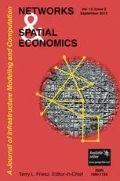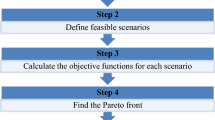Abstract
This paper presents a robust optimization formulation, with an exact solution method, that simultaneously solves continuous network capacity expansion, traffic signal optimization and dynamic traffic assignment when explicitly accounting for an appropriate robustness measure, the inherent bi-level nature of the problem and long-term O-D demand uncertainty. The adopted robustness measure is the weighted sum of expected total system travel time (TSTT) and squared up-side deviation from a fixed target. The model propagates traffic according to Daganzo’s cell transmission model. Furthermore, we formulate five additional, related models. We find that when evaluated in terms of robustness, the integrated robust model performs the best, and interestingly the sequential robust approach yields a worse solution compared to certain sequential and integrated approaches. Although the adopted objective of the integrated robust model does not directly optimize the variance of TSTT, our experimental results show that the robust solutions also yield the least-variance solutions.



Similar content being viewed by others
References
Bard JF (1998) Practical bilevel optimization algorithms and applications. Kluwer Academic, Dordrecht
Birge JR, Louveaux F (1997) Introduction to stochastic programming. Springer, New York
Chiou S-W (2005) Modeling a continuous network design problem for signal-controlled road network. Presented at 84th Annual Meeting of the Transportation Research Board, Washington, D.C
Daganzo CF (1994) The cell transmission model: a simple dynamic representation of highway traffic consistent with the hydrodynamic theory. Transp Res 28B:269–287
Fortuny-Amat J, McCarl B (1981) A representation and economic interpretation of a two-level programming problem. J Oper Res Soc 32:783–792. doi:10.2307/2581394
Grossmann IE, Viswanathan J, Vecchietti A, Raman R, Kalvelagen E (2002) GAMS/DICOPT: a discrete continuous optimization package. GAMS Development Corporation, Washington, D.C
Infanger G (1992) Monte Carlo (Importance) Sampling with a benders decomposition algorithm for stochastic linear programs. Ann Oper Res 39:69–95. doi:10.1007/BF02060936
Kalantari B, Rosen JB (1982) Penalty for zero-one equivalent problem. Math Program 24:229–232. doi:10.1007/BF01585106
Kall P, Wallace SW (1994) Stochastic programming. Wiley, Chichester
Karoonsoontawong A (2006) Robustness approach to the integrated network design problem, signal optimization and dynamic traffic assignment problem. Ph.D. Dissertation, The University of Texas at Austin
Karoonsoontawong A, Waller ST (2005) A comparison of system- and user-optimal stochastic dynamic network design models using Monte Carlo bounding techniques. J Transp Res Board 1923:1–102
Karoonsoontawong A, Waller ST (2006) Dynamic continuous network design problem: linear bi-level programming and metaheuristics. J Transp Res Board 1964:104–117
Karoonsoontawong A, Waller ST (2007) Robust dynamic continuous network design problem. J Transp Res Board 2029:58–71
Lee C (1998) Combined traffic signal control and traffic assignment: algorithms, implementation and numerical results. Ph.D. Dissertation, The University of Texas at Austin, Austin, Texas
Mak W, Morton DP, Wood RK (1999) Monte Carlo bounding techniques for determining solution quality in stochastic programs. Oper Res Lett 24:47–56. doi:10.1016/S0167-6377(98)00054-6
Markowitz H (1991) Portfolio selection, efficiency diversification of investments. Cowles Foundation Monograph 16, Yale University Press, New Haven, Conn., 1959 (second edition, Basil Blackwell, Cambridge
Morton DP (2006) Personal discussion. Operations Research and Industrial Engineering Program, The University of Texas at Austin
Mulvey JM, Vanderbei RJ, Zenios SA (1995) Robust optimization of large scale systems. Oper Res 43(2):264–281
Munoz L, Xiaotian S, Sun D, Gomes G, Horowitz R (2004) Methodological calibration of the cell transmission model. Proceeding of the 2004 American Control Conference, Boston, Massachusetts
Ran B, Boyce DE (1996) A link-based variational inequality formulation of ideal dynamic user-optimal route choice problem. Transp Res Part C 4(1):1–12. doi:10.1016/0968-090X(95)00017-D
Ukkusuri SVSK (2002) Linear programs for the user optimal dynamic traffic assignment problem. Master’s Thesis, University of Illinois at Urbana-Champaign
Ukkusuri SV, Waller ST (2007) Linear programming models for the user and system optimal dynamic network design problem: formulations, comparisons and extensions. Networks and Spatial Economics. doi:10.1007/s11067-007-9019-6
Von Stackelberg H (1952) The theory of the market economy. Oxford University Press, Oxford
Waller ST (2000) Optimization and control of stochastic dynamic transportation systems: formulations, solution methodologies, and computational experience. Ph.D. Dissertation, Northwestern University
Waller ST, Ziliaskopoulos AK (2006) A combinatorial user optimal dynamic traffic assignment algorithm. Annual Operations Research, ISSN: 0254-5330, 1572-9338
Ziliaskopoulos AK (2000) A linear programming model for the single destination system optimum dynamic traffic assignment problem. Transp Sci 34(1):37–49. doi:10.1287/trsc.34.1.37.12281
Ziyou G, Yifan S (2002) A reserve capacity model of optimal signal control with user-equilibrium route choice. Transp Res Part B 36:313–323. doi:10.1016/S0191-2615(01)00005-4
Acknowledgments
This research is based on work supported by the National Science Foundation (NSF) project “CAREER: Accounting for Information and Recourse in the Robust Design and Optimization of Stochastic Transportation Networks” and the Southwest Region University Transportation Center (SWUTC) project SWUTC/06/167867 “Multimodal Network Models for Robust Transportation Systems.” The work presented in this paper remains the sole responsibility of the authors.
Author information
Authors and Affiliations
Corresponding author
Appendix
Appendix
1.1 Reduction of MZC-QL-BLPP to QL-BLPP
The proof closely follows the work by Bard (1998) and Kalantari and Rosen (1982). Next, consider the standard optimization problem Eq. (12):
where \(P = \cup ^{l}_{{i = 1}} P^{\prime }_{i} \) such that \(P_i^\prime \) is a polyhedral set for i = 1,2,…,l and l is a positive integer. The optimal solution of Eq. (12) is denoted by \(\left( {x_1^* ,x_2^* ,y^* } \right)\). Denote the feasible region of Eq. (12) by F:
In this appendix, we will show that the mixed zero-one quadratic program Eq. (12) can be reduced to a quadratic program Eq. (13):
where \(\theta :R^{n_2 } \to R\) is a continuous function such that θ(x 2) ≥ 0 for all \(0 \leqslant x_2 \leqslant e_{n_2 } \) and \(\theta \left( {x_2 } \right) = 0\) if and only if \(x_2 \in \left\{ {0,1} \right\}^{n_2 } \). \(e_{n_2 } \) is a vector of ones with dimensions n 2 . The optimal solution of Eq. (13) is denoted by \(\left( {\widetilde{x_1}},{\widetilde{x_2}},{\widetilde{y}} \right)\). We denote the feasible region of Eq. (13) by \(\tilde F\):
Thus, \(F = {\left( {R_ + ^{n_1 } \times \left\{ {0,1} \right\}^{n_2 } \times R_ + ^m } \right)} \cap \tilde F\). It can be assumed without loss of generality that \(c_{11} \leqslant 0\) , \(c_{12} \leqslant 0\), and \(d_1 \leqslant 0\). If the ith component of c 11 (respective c 12 and d 1) is positive, it is always possible to define a new variable \(x_{1_i }^\prime = 1 - x_{1_i } \) (\(x_{2_i }^\prime = 1 - x_{2_i } \), \(y_i^\prime = 1 - y_i \)) and make the appropriate substitutions to yield an equivalent program satisfying this requirement.
Theorem 1
If θ is a concave function, there exists a positive real number M such that the problem Eq. (12) and the problem Eq. (13) have the same optimal solutions.
Proof
If \(\theta \left( {\tilde x_2 } \right) = 0\), then the result is true for any positive value of M. Suppose \(\theta (\tilde x_2 ) >0\). Consider Eq. (12) when the integrality requirement is relaxed, giving problem Eq. (14):
Let \(\left( {x_1^0 ,x_2^0 ,y^0 } \right)\)denote the optimal solution of Eq. (14).
Consider the following Eq. (15) with the optimal solution \(\left( {\overline x _1 ,\overline x _2 ,\overline y } \right)\):
If \(\theta \left( {\overline x _2 } \right) = 0\), then the result is true for any positive value of M. Suppose that \(\theta \left( {\overline x _2 } \right) >0\).
Next, define M in Eq. (13) such that
Then, \(f\left( {x_1^* ,x_2^* ,y^* } \right) - f\left( {\widetilde{x_1}} ,{\widetilde{x_2}} ,{\widetilde{y}} \right)\)
(from definition of Eq. (14))
This establishes a contradiction since from the definition of Eq. (13), \(f\left( {x_1^* ,x_2^* ,y^* } \right) - f\left( {\widetilde{x_1}} ,{\widetilde{x_2}} ,{\widetilde{y}} \right) \geqslant 0.\)
Thus, \(\theta \left( {\overline x _2 } \right) = 0\), \(\theta \left( {\tilde x_2 } \right) = 0\) and \(\left( {\widetilde{x_1}} ,{\widetilde{x_2}} ,{\widetilde{y}} \right) \in F\). From the definition of Eq. (13),
From the definition of Eq. (12), \(z\left( {x_1^* ,x_2^* ,y^* } \right) - z\left( {\widetilde{x_1}} ,{\widetilde{x_2}} ,{\widetilde{y}} \right) \leqslant 0.\)
Therefore, \(z\left( {x_1^* ,x_2^* ,y^* } \right) = z\left( {\widetilde{x_1}} ,{\widetilde{x_2}} ,{\widetilde{y}} \right)\).
Theorem 2
There exists a positive real M′ such that MZC-QL-BLPP [Eqs. (10.1)–(10.6)] and QL-BLPP(M′) [Eqs. (11.1)–(11.8)], have the same optimal solutions.
Proof
From the theoretical properties of L-BLPP in Bard (1998), the inducible region IR can be stated as \(IR = \left\{ {\left( {x_1 ,x_2 ,y} \right):A_{11} x_1 + A_{12} x_2 + B_1 y \leqslant b_1 ,y \in \arg \min \left( {d_2 y:B_2 y \leqslant b_2 - A_{21} x_1 - A_{22} x_2 ,y \geqslant 0} \right)} \right\}\).
The inducible region is a finite union of polyhedral sets. Thus, MZC-QL-BLPP is a special case of problem Eq. (12) mentioned in Theorem 1. If we define \(\theta \left( {x_2 } \right) = \sum\limits_{j = 1}^{n_2 } {\min \left\{ {x_2}{ _j} ,1 - {x_2}{ _j } \right\}} \), which is a concave function in x 2 , then we can apply Theorem 1 to assure the existence of a real positive M′ such that MZC-QL-BLPP and the problem Eqs. (16.1)–(16.6) have the same optimal solutions.
However, the problem Eqs. (16.1)–(16.6) is equivalent to QL-BLPP(M′) Eqs. (11.1)–(11.8), since the lower–level optimality in QL-BLPP(M′) enforces u j to be equal to \(\min \left\{ {x_2}{ _j} ,1 - {x_2}{ _j } \right\}\) for all \(j \in \{ 1,...,n_2 \} \). We establish the equivalence between MZC-QL-BLPP and QL-BLPP(M′).
Rights and permissions
About this article
Cite this article
Karoonsoontawong, A., Waller, S.T. Integrated Network Capacity Expansion and Traffic Signal Optimization Problem: Robust Bi-level Dynamic Formulation. Netw Spat Econ 10, 525–550 (2010). https://doi.org/10.1007/s11067-008-9071-x
Published:
Issue Date:
DOI: https://doi.org/10.1007/s11067-008-9071-x




